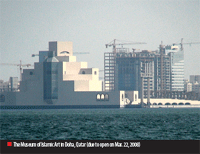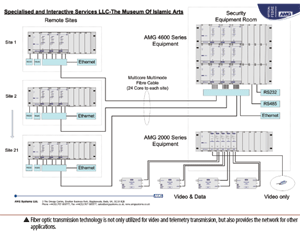Scheduled to be open in Spring 2008, the Museum of Islamic Art in Doha, Qatar is one of the most inspiring projects of its kind in the world. It has been a challenge for the project planners to reach a balance in protecting the valuable artifacts and making the Museum an open and friendly environment to the visitors. The solution is to implement the art surveillance and security technology systems based on fiber optic transmission technology.
Scheduled to be open in Spring 2008, the Museum of Islamic Art in Doha, Qatar is one of the most inspiring projects of its kind in the world. It has been a challenge for the project planners to reach a balance in protecting the valuable artifacts and making the Museum an open and friendly environment to the visitors. The solution is to implement the art surveillance and security technology systems based on fiber optic transmission technology.
Designed by world-famous architect I. M. Pei, who also designed the glass pyramid in the Louvre, the entire project of Museum of Islamic Arts encompasses a massive 45,000 square meters. The museum is situated on the southern part of the Doha seafront on an artificial island about 60 meters off the coast. The Museum will display the Qatar National Collection of Islamic Art, a world class collection of ceramics, metalwork, jewellery, woodwork, glass and other items made in countries all over the Islamic world.
Comprehensive Surveillance
 A comprehensive security and surveillance solution for the Museum is of course a must, and there are serious considerations to be made with regards to the overall design. ¨Designing the comprehensive security plan for the Museum of Islamic Art involved balancing the need to ensure the security of the artifacts and safety of staff and visitors with the need to make the Museum accessible, welcoming and user friendly, 〃 Explained Brian T. Connor, Head of Security & Safety, Qatar Museums Authority.
A comprehensive security and surveillance solution for the Museum is of course a must, and there are serious considerations to be made with regards to the overall design. ¨Designing the comprehensive security plan for the Museum of Islamic Art involved balancing the need to ensure the security of the artifacts and safety of staff and visitors with the need to make the Museum accessible, welcoming and user friendly, 〃 Explained Brian T. Connor, Head of Security & Safety, Qatar Museums Authority.
Consultant Kevin Gausden from Quadrant Security Group worked on the specifications for the project and he explains the design of the surveillance solution in more details. "The design criteria required pre-alarm images from all 420 cameras being recorded at real-time (25 frames per second) uncompressed video. An IP solution would not have met the criteria due to inherent issues regarding latency/bandwidth requirements and video compression techniques.¨
"A multi-core fibre backbone infrastructure is utilized to carry multiple disciplines from local f loor cont rol c abine t s to the security equipment room, where the receivers convert the images back to coax terminations on a real time uncompressed video basis,〃 said Gausden. A modular digital recording system is installed as the front-end integrated control system and records the images on a time-lapse later basis, thus providing the requirements of the real time pre-alarm.

The fibre optic products were not only utilized for video and telemetry transmission, but also provided the network for the artwork RFID tagging system using the inbuilt RS232/485 ports. Other applications, such as alarm gathering nodes and Ethernet medium bandwidth connectivity, were also delivered via the fibre optic transmission. ¨The RFID tagging system delivers the signals from pressure pads on the exhibition displays as well as vibration detection and door-to-door magnetic reads. Tests were carried out to confirm compatibility prior to approval being given to the use of the RS ports being utilized for the network infrastructure. This also provided a project cost saving against the use of individual fibre converters and allowed fibre cores to be saved for future project expansion,〃 Gausden further explained.
More on Product Specifications
With an original total budget of approximately US $ 239 million (of which the security solution alone was for $5.25 million), the contract for this prestigious project was the target of fierce competition in the industry. Specialized & Interactive Systems based in Dubai was awarded with the contract. ¨The AMG line of products were familiar to us as we had considered them on some projects in Dubai prior to the Museum project,〃 commented Bruce Haigh, General Manager at SIS. ¨In terms of price there were other suppliers that were aggressively targeting this project and who had offered us better pricing. In the end the product specification and quality as well as the support we received, were the criteria that influenced our final decision in selecting the supplier for the CCTV transmission system.〃
SIS installed a fully dual redundant system using a series that is specifically designed for low cost multi-channel point-to-point video transmission over multimode optical fibre, together with associated Ethernet and low speed data and audio signals. It is a highly resilient, managed, low cost, transmission system for both compressed and uncompressed video signals, and is available for four and eight channel point-to-point video transmission with data/audio and Ethernet in dual redundant applications.
A total of 420 cameras are installed of which 21 are Pan Tilt Zoom (PTZ). Most of these are installed inside the Museum although a certain number of cameras cover the perimeter and the surrounding parkland.
A special feature is the 4 radar pods on the building which are sweeping the sea approach constantly that are connected into the transmission system. Hence, when a movement is spotted the nearest camera automatically is set to trail the boat or the diver, across the bay for visual verification and threat assessment.
¨The camera signals are routed to two control rooms however future planning is looking at establishing a single central control centre to which all individual site control rooms will report via the WAN. All the cameras can be viewed at any time in any of the control rooms, as long as the operator is given viewing privileges,〃 concluded Haigh.